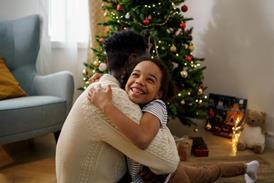Halloween poses specific challenges for youth and children with additional needs - Mark Arnold proposes 10 ways to deal with the issues that arise at this season

Halloween is a time of the year that, whether we like it or not, many children really look forward to. It’s a time for fantasy and fun, a time for dressing up and scary stories, a time for ‘trick or treat’ adventures and lots of sweets!
The advertising and marketing around Halloween seems to ramp up to greater and greater heights every year, with major supermarkets dedicating whole aisles, sometimes several of them, to their Halloween merchandise. Advertising supports this with lots of TV adverts featuring images of ghosts, ghouls, pumpkins and spiders’ webs.
for those with additional needs it can be a confusing, anxiety-inducing or even utterly terrifying time
Whatever your feelings regarding Halloween, and these vary widely across the Church, as parents we can at least help children to avoid the worst excesses, provide an alternative, have appropriate fun, and stay safe.
While Halloween can be a fun time of year for many children, it can be a really difficult time for some, including many children with additional needs. For them it can be a confusing, anxiety-inducing or even utterly terrifying time.
But it doesn’t have to be like that; if we stop for a moment to think about the things they might find hard and how to put alternative things in place to help them, they can safely join in with some fun too but in an alternative way. So, what are some of the things about Halloween that children with additional needs can particularly find hard, and what can we offer them in our ‘alternative Halloween’ instead?
The problems with Halloween for those with additional needs
Stranger danger?
We tell children all year not to talk to strangers, then on one night it’s suddenly fine to go around knocking on strangers’ doors. This can be hugely difficult for some neurodiverse children, for example, who can be very literal in their understanding and so can be very confused by this. Why is it OK to speak to strangers today but it wasn’t yesterday? What has changed? What will the rules be tomorrow? Why?
Fake or real?
The more garish dressing up can be genuinely terrifying for a child who struggles to tell the difference between fake and real. Increasingly, we’re seeing dressing-up outfits becoming more realistic with fake gore and movie-quality make-up that makes people look truly terrifying. When that line is crossed for a child that believes that the person really has hideous injuries or has been turned into something truly evil, theirs is the terror that is real. Cue massive meltdowns, sleepless nights and recurring anxiety.
I’m scared enough already!
Talking about anxiety, some children with ongoing anxiety issues can find the whole business of going out trick or treating very upsetting in itself. Surprises, scares, people jumping out can all be terrifying. If it’s hard to deal with the day-to-day anxiety that they face about going out on a regular day, ramp this up multiple times when Halloween is involved!
What about me?
Then there are the kids with additional needs or disabilities that don’t get invited to the parties or to go out trick or treating because they are viewed as ‘different’ (usually by other parents, rather than the other children). Here’s yet another opportunity for them to feel left out, rejected and uninvited because they haven’t been included…again.
Parent problems!
It’s not just the kids. Parents of children with ADHD for example may not be grateful for their children being given loads of sugary colourful sweets when they are then up all night with a hyperactive sugar-fuelled child!
Read more:
Navigating Halloween with kids through chocolate, conversation and Jesus
5 ways Christian parents can redeem autumn in the lives of their youth and children
How Christian families can help shine a light this Halloween
10 things you can do to help
There are loads of other reasons beside these to avoid Halloween, but there are also many ways to offer an alternative to Halloween for all children, but especially for those with additional or special needs so that they can join in too. Here are ten ideas:
- Prepare them in advance, giving them a visual timetable of what is going to happen, how and when. This will help them to be less anxious about what might happen.
- Prime some friendly neighbours or members of your congregation who are known to the children and that you can visit safely knowing that they won’t do anything scary or surprising. They can, for example, have their outdoor lights on and a bucket of packets of sweets or snacks ready for the children to enjoy safely. Maybe the children could sing their favourite song as a ‘thank you’.
- If you are near the countryside or a park, go for an autumn walk (or roll, make sure your route is accessible), collecting conkers and fir cones, picking blackberries, kicking or throwing up the fallen leaves, looking up at the stars. Remind the children to bring torches with them and have some hot chocolate and biscuits ready for when you get back to your church.
- Provide ear defenders for children with sensitivity to loud noise so that any unexpected noises (fireworks for example) are less of a problem.
- Choose alternative ‘bright and light’ outfits. It’s more about the dressing up than who can look the most terrifying and there are plenty of non-scary, positive options to choose from.
- With this in mind, host an alternative light party – a countercultural celebration of things that are bright, light, colourful and good. Loads more variety with the dressing up, just as much fun and no scares! Who can dress up in the brightest costume?!
- Choose sugar-free sweets, or better yet try some healthier snacks themed around Halloween (satsumas as ‘mini pumpkins’ with a smiley face for example).
- Have an autumn indoor picnic, where you spread out some blankets and enjoy a feast together or, if the weather is good, an autumn barbeque with lots of lighting to keep it bright.
- Think about who might be left out and make sure you remember to invite them.
- Have fun but keep checking on how each child is feeling. If they are struggling, have something that they love doing ready so that they can easily try that and have fun in a different way (carving pumpkins – they don’t have to be scary, making pumpkin mini-pies, decorating a jar to put a battery-operated tealight in, apple bobbing, toasting marshmallows…). And have a ‘safe space’ they can access if they just need a rest from all of the activities. Fill it with cosy blankets, cushions and provide soft lighting.


































